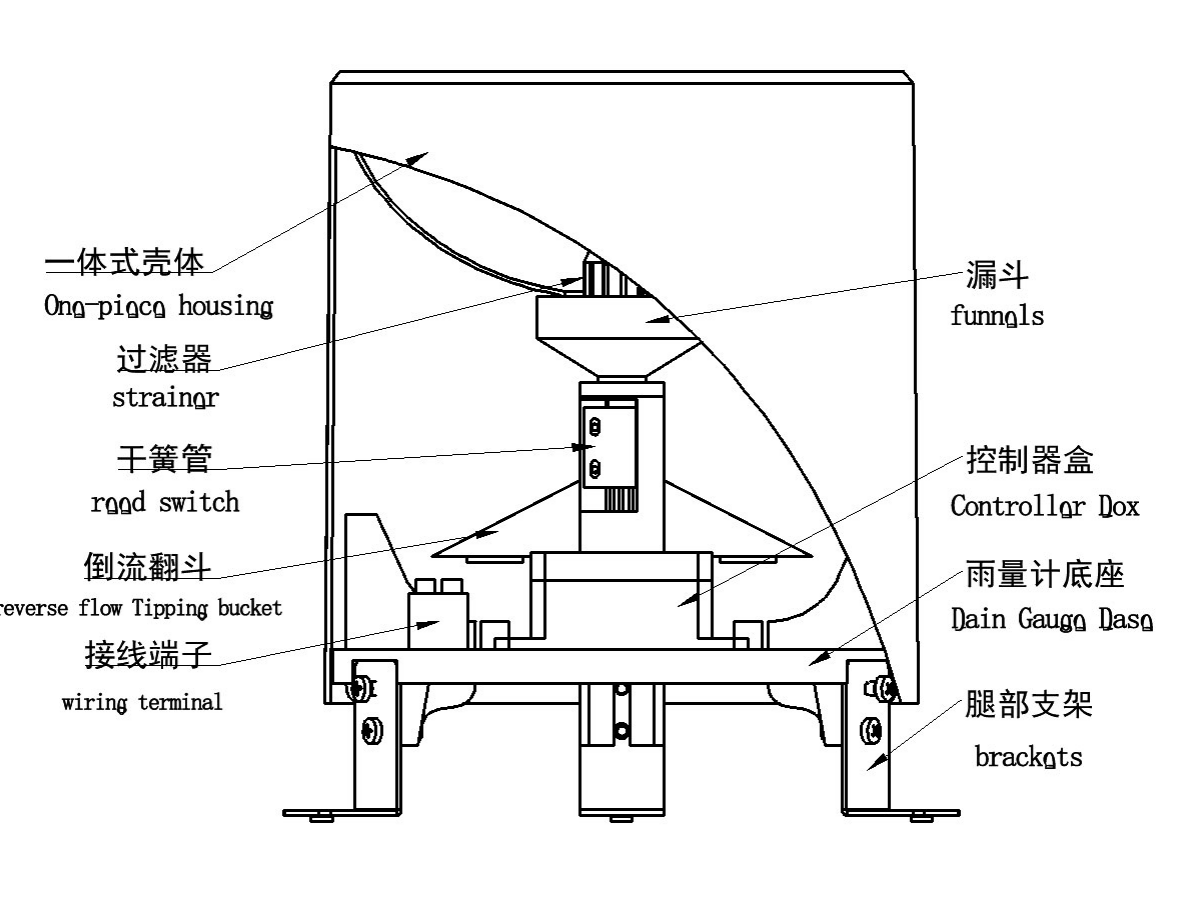

— Blogs —
—Products—
 Consumer hotline +8618073152920
Consumer hotline +8618073152920 WhatsApp:+8615367865107
Address:Room 102, District D, Houhu Industrial Park, Yuelu District, Changsha City, Hunan Province, China
Product knowledge
Time:2023-09-07 15:50:02 Popularity:2443
Tipping Bucket Rain Gauge Introduction:
Tipping bucket rain gauges are widely used instruments for measuring rainfall accurately. In this article, we will explore what a tipping bucket rain gauge is, how it works, and the valuable applications it has.
A tipping bucket rain gauge is a weather instrument designed to measure the amount of precipitation, specifically rainfall. It consists of a collecting funnel that directs the rainfall into a small bucket mechanism. This mechanism is balanced in such a way that it tips to one side when a predefined amount of water (typically 0.2 mm or 0.01 inches) is collected. The tipping action is then recorded as a pulse or increment in a counter or electronic sensor.
Part 2: Working Principle of a Tipping Bucket Rain Gauge
The working principle of a tipping bucket rain gauge is relatively simple but effective. Here's how it works:
1. Collection: Rainfall is collected through the funnel-shaped opening of the rain gauge. The size of the opening determines the area over which rainfall is measured, usually expressed in square millimeters or square inches.
2. Tipping Mechanism: The collected water flows into a small seesaw-like component known as the tipping bucket. This bucket is balanced in such a way that it normally remains level, but when a specific amount of water is collected, it tips to the other side.

3. Tipping Action: As the bucket tips, it causes a momentary interruption in an electrical circuit or triggers a magnetic switch. This generates an electrical pulse or signal, which is recorded as a measurement. Each tip typically represents a fixed unit of rainfall, such as 0.2 mm or 0.01 inches.
4. Recording and Calculation: The electrical pulses or signals generated by the tipping action are counted by a recorder or electronic data logger. These counts can be converted into rainfall amounts over a specific time period, providing accurate measurements of precipitation.

Part 3: Application Value of Tipping Bucket Rain Gauges
Tipping bucket rain gauges offer several valuable applications in various fields:
1. Weather Monitoring: Tipping bucket rain gauges are essential tools for meteorologists and weather enthusiasts to gather accurate and real-time rainfall data. This data helps in predicting and analyzing weather patterns, assessing drought conditions, and monitoring climate changes.
2. Flood Management: By continuously measuring rainfall intensity and duration, tipping bucket rain gauges play a crucial role in flood forecasting and early warning systems. They provide vital information to help authorities make informed decisions regarding flood prevention, evacuation, and emergency response.
3. Agriculture and Irrigation: Farmers and agricultural professionals rely on accurate rainfall measurements to determine irrigation needs, crop water requirements, and water resource management. Tipping bucket rain gauges support efficient and sustainable agricultural practices.
4. Engineering and Urban Planning: Tipping bucket rain gauges assist in determining the proper design and capacity of stormwater drainage systems. They help engineers and urban planners assess the impact of rainfall events on infrastructure, mitigate urban flooding risks, and develop effective stormwater management strategies.
5. Research and Education: Tipping bucket rain gauges are used in scientific research projects, educational institutions, and environmental studies. They aid in understanding regional precipitation patterns, climate modeling, and long-term climate change analysis.

Conclusion:
Tipping bucket rain gauges accurately measure rainfall by utilizing a simple tipping mechanism. They find valuable applications in weather monitoring, flood management, agriculture, engineering, and research. With their precise measurement capabilities, tipping bucket rain gauges contribute significantly to decision-making processes, resource management, and our understanding of precipitation patterns and climate changes.
Prev:Weather Station for Agriculture: Working Principle, and Application Value
Next:Solar Radiation Sensors: Common Failures, Repair Tips and Installation Requirements
Related recommendations
Sensors & Weather Stations Catalog
Agriculture Sensors and Weather Stations Catalog-NiuBoL.pdf
Weather Stations Catalog-NiuBoL.pdf
Related products
 Combined air temperature and relative humidity sensor
Combined air temperature and relative humidity sensor Soil Moisture Temperature sensor for irrigation
Soil Moisture Temperature sensor for irrigation Soil pH sensor RS485 soil Testing instrument soil ph meter for agriculture
Soil pH sensor RS485 soil Testing instrument soil ph meter for agriculture Wind Speed sensor Output Modbus/RS485/Analog/0-5V/4-20mA
Wind Speed sensor Output Modbus/RS485/Analog/0-5V/4-20mA Tipping bucket rain gauge for weather monitoring auto rainfall sensor RS485/Outdoor/stainless steel
Tipping bucket rain gauge for weather monitoring auto rainfall sensor RS485/Outdoor/stainless steel Pyranometer Solar Radiation Sensor 4-20mA/RS485
Pyranometer Solar Radiation Sensor 4-20mA/RS485
Screenshot, WhatsApp to identify the QR code
WhatsApp number:+8615367865107
(Click on WhatsApp to copy and add friends)